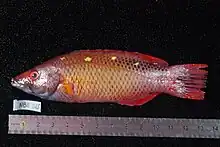Diana's hogfish
Diana's hogfish, Bodianus diana, is a species of wrasse native to the Indian Ocean from the African coast to the Nicobars and the Cocos-Keeling Islands. Reports of its presence in the western Pacific Ocean are erroneous. It occurs on the seaward side of reefs at depths from 6 to 50 m (20 to 164 ft) (though rarely deeper than 25 m (82 ft)). It can reach a length of 16.9 cm (6.7 in). This species is of minor importance to local commercial fisheries and is found in the aquarium trade.[2]
| Diana's hogfish | |
|---|---|
 | |
| Scientific classification | |
| Domain: | Eukaryota |
| Kingdom: | Animalia |
| Phylum: | Chordata |
| Class: | Actinopterygii |
| Order: | Labriformes |
| Family: | Labridae |
| Genus: | Bodianus |
| Species: | B. diana |
| Binomial name | |
| Bodianus diana (Lacépède, 1801) | |
| Synonyms | |
| |
Habitat
Diana's hogfish is generally found in the Indo-Pacific region including the Red Sea and East Africa towards the Marshall Islands.[3] Juveniles have been observed living among the tentacles of the mushroom coral Heliofungia actiniformis.[4][5]
Diet
Diana's hogfish feeds mainly on benthic invertebrates such as mollusks and crustaceans. Juveniles are known to remove parasites from other fishes.[1]
Utilization
This species is collected for the aquarium trade.[1]
References
- Russell, B. (2010). "Bodianus diana". IUCN Red List of Threatened Species. 2010: e.T187587A8575387. doi:10.2305/IUCN.UK.2010-4.RLTS.T187587A8575387.en. Retrieved 20 November 2021.
- Froese, Rainer; Pauly, Daniel (eds.) (2013). "Bodianus diana" in FishBase. August 2013 version.
- Diana's hogfish's habitat
- Bos, A.R. & B.W. Hoeksema (2015). "Cryptobenthic fishes and co-inhabiting shrimps associated with the mushroom coral Heliofungia actiniformis (Fungiidae) in the Davao Gulf, Philippines". Environmental Biology of Fishes. 98 (6): 1479–1489. doi:10.1007/s10641-014-0374-0. S2CID 14834695.
- Bos, A.R. (2012). "Fishes (Gobiidae and Labridae) associated with the mushroom coral Heliofungia actiniformis (Scleractinia: Fungiidae) in the Philippines". Coral Reefs. 31 (1): 133. doi:10.1007/s00338-011-0834-3.
External links
